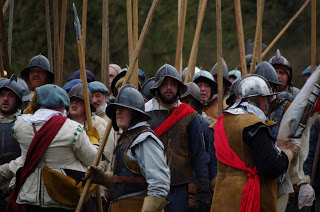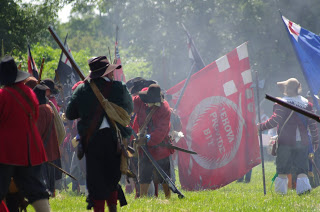Sir James Dillon's Regiment of Foot
Just when you think that things can't get any more complicated, along comes James Dillon and his regiment. Only there are two James Dillons; well, that's not strictly true, there's load of them. Initial research brings back lots of information, and a flag design, but then you realise that it is Dillon's Regiment serving the exiled James II in France, and the French in the Williamite wars (which has its roots in this Regiment). Oh, and just to confuse matters, 'our' James Dillon had two regiments, one of horse and one of foot, and it isn't always clear which is which. With that caveat, I hope I have this right...
James was born in 1600, the eighth son of Theobald, 1st Viscount Dillon, and Eleanor, the daughter of Sir Edward Tuite of Tuitestown, Co. Westmeath, and widow of William Tuite of Monilea.
His father, Theobald, was appointed chief sergeant, and general collector and receiver, for Connacht and Thomond in May 1582. In 1585 he acquired ownership of the entire barony of Costello in Co. Mayo, and also procured additional lands in Co. Roscommon. Theobald Dillon was knighted by the earl of Essex in 1599 and created Viscount Dillon of Costello-Gallen in March 1622. As he was predeceased by his eldest son, Sir Christopher Dillon, the title passed to his fourteen-year-old grandson Sir Lucas Dillon in 1624.
In 1627 James Dillon was selected as one of the commissioners delegated to raise money for the army in Ireland. He became a freeman of Dublin in 1632 and was elected MP for County Westmeath to the 1634 parliament. He was listed as a captain in the regiment of Eoghan Ruadh Ó Néill at Cambrai in 1636, being the first Dillon to serve in a foreign army.
James returned to Ireland later that year and, in 1640, was re-elected as MP for County Westmeath.
With the creation of the ‘new’ Irish army of Thomas Wentworth in 1640, James served as a captain in Charles Coote's Regiment. When the army was disbanded, he was one of nine officers authorised by Charles I to recruit regiments from among the disbanded soldiers for military service in Spain.
James lost the £1,000 he invested in the project, when it was halted because of growing political tensions between king and parliament. In the early autumn of 1641, before the outbreak of rebellion, he was involved in discussions with Rory Maguire regarding the proposed ‘colonels’ plot’ to seize Dublin castle, though he later appears to have withdrawn his support for the conspiracy.
He was not in Dublin when rebellion broke out in October 1641 and the Lords Justices seem to have been unaware of his involvement in the plot, as they sent him arms and appointed him joint governor of Longford, alongside his namesake Sir James Dillon, son of the Earl of Roscommon (a cousin).
Dillon subsequently became active in the rebellion in counties Longford and Westmeath, and it is about this time when he raised his Regiment of Foot.
He and his RoF were present at the siege of Athlone: he escorted protestant residents of Athlone, through the siege lines, to safety; though he kept the Lord President of Connacht, Lord Ranelagh, confined in Athlone until July 1642, when he was forced to lift the siege.
On 22nd June 1642 he was indicted for rebellion and expelled from the Irish House of Commons. Dillon was at the siege of Birr in January 1643 and the following March his regiment was in the area of the battle of Ross, though it took no part in the battle.
Throughout the 1640s he was a member of the Confederate Council of War for County Westmeath. Despite the cessation of hostilities, agreed in September 1643, Dillon wrangled with Ormond for control of Athlone.
In 1644 his 1000 strong regiment formed part of the futile expedition led by Castlehaven to Ulster, and he was also involved in reducing County Roscommon.
In 1645 Dillon was listed as a commander for Connacht and his regiment formed part of Preston's army that campaigned in the region in 1646. Part of his regiment also served under Oliver Fitzwilliam in County Roscommon. Dillon was personally involved in the siege of Roscommon town, following which he was appointed governor of Jamestown.
In 1647 Dillon was one of the Confederate officers who maintained his regiment in the hope of taking it into French service. Although Ormond recommended him to the French agent Dumolin, he was prevented from taking his men into the French service by a lack of funds.
Summer 1649, his regiment formed part of the force led by Inchiquin that captured Drogheda and Dundalk. Two hundred men of his RoF were present at Drogheda when it was stormed by Oliver Cromwell, though it is appears that Dillon was not present.
Ormond appointed James as joint governor of Athlone, where he was active in organising the region's defences. On 18th June 1651, with two Parliamentarian armies advancing on his position, Dillon surrendered the town. The surrender greatly weakened the Royalist line of defence behind the Shannon and there were rumours of treachery. In 1652 he agreed to lay down his arms and remain in Mullingar.
He seems to have returned to Ireland, however, as in 1666 he carried draft bills to London for the English secretary of state, Lord Arlington, and he was also a signatory of the loyal catholic remonstrance to the king. In 1667 he sought a licence to manufacture a new type of fuel. Married twice, Dillon left no surviving children.
Clothing colours are based upon Sir J T Gilbert's (History of the Irish Confederation and the War In Ireland 1641-1643) description of the Confederates fighting at Kilrush being almost indistinguishable from the bog due to the dark colours they wore.
The flag is a temporary affair. Last week's post explains why I need to replace the flag I've chosen here, and all of the flags for my Irish regiments of foot (including those of the Irish Brigade from Montrose's Army). Update: I've now reflagged the regiment. Here's what they look like now...
A number of headswaps here, and a few figures from the spares box to add some 'difference', a couple of Scots, and an 'English' pikeman. Custom casualty marker from Warbases. Flag, as always, from Maverick Models (Stuart is currently adapting the Irish flags so that they fit the contemporary descriptions).
 |
These were the first figures that I painted utilising my new x2 reading glasses. They seemed to take for ever to paint, probably because I kept going back to correct all my mistakes, rather than leaving mistakes to be hidden by the great panacea that is Nuln Oil. Hopefully you can tell the difference.








.jfif)








Excellent all round Mike.
ReplyDelete